Gee’s Bend, Alabama
 Tuesday, October 14, 2008 at 5:07PM
Tuesday, October 14, 2008 at 5:07PM 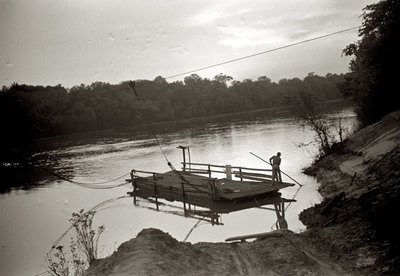 “I do not know much about gods,” T.S. Eliot writes in “The Dry Salvages,” “but I think the river / Is a strong brown god…”
“I do not know much about gods,” T.S. Eliot writes in “The Dry Salvages,” “but I think the river / Is a strong brown god…”

“My soul has grown deep like the rivers,” Langston Hughes says.
 And then at one point, the Alabama River decided to bow itself into a great U-shape just so that it could enclose a bulb of land on three sides and create a virtual river-island that would come to be called Gee’s Bend after an early plantation owner.
And then at one point, the Alabama River decided to bow itself into a great U-shape just so that it could enclose a bulb of land on three sides and create a virtual river-island that would come to be called Gee’s Bend after an early plantation owner.
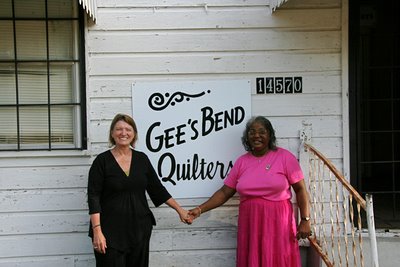 Mary Ann Pettway had invited us to come stay with her. We slept beneath one of her own quilts. She made breakfasts of grits, sausages, bacon, eggs, coffee for us – and regaled us with stories and photos of her family. That is, she laid out before us, like in the piecework of a quilt, the history of Gee’s Bend.
Mary Ann Pettway had invited us to come stay with her. We slept beneath one of her own quilts. She made breakfasts of grits, sausages, bacon, eggs, coffee for us – and regaled us with stories and photos of her family. That is, she laid out before us, like in the piecework of a quilt, the history of Gee’s Bend.
That history is too complex for us to piece together for you here. But that’s already been well done anyway – and we highly recommend to you J.R. Moehringer’s series on Gee’s Bend that he wrote for the L.A. Times in 1999. The series received a Pulitzer Prize, and it’s also a portrait of Mary Lee Bendolph, whom we’ll introduce to you tomorrow.
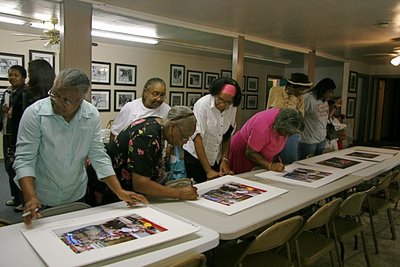 Mary Ann Pettway is the president of the Gee’s Bend Quilting Collective. The quilters were having a meeting our second day in Gee’s Bend.
Mary Ann Pettway is the president of the Gee’s Bend Quilting Collective. The quilters were having a meeting our second day in Gee’s Bend.
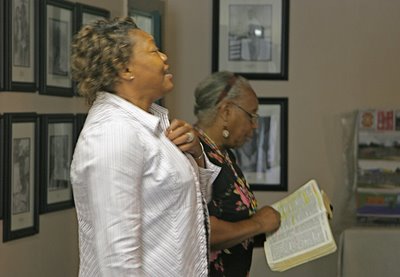 The meeting began with a spiritual and a verse, led by China Pettway and Mary Lee Bendolph. The rhythms of their faith are as ever-present as the river. I’m listening to these rhythms right now as I type. It’s one small way to try to keep these people with us.
The meeting began with a spiritual and a verse, led by China Pettway and Mary Lee Bendolph. The rhythms of their faith are as ever-present as the river. I’m listening to these rhythms right now as I type. It’s one small way to try to keep these people with us.
 Gee’s Benders keep the dead with them, too. If you pay attention, you see commemorations everywhere.
Gee’s Benders keep the dead with them, too. If you pay attention, you see commemorations everywhere.
 “For generations, their secret art – created in slavery, perfected in solitude – had kept them warm…”
“For generations, their secret art – created in slavery, perfected in solitude – had kept them warm…”
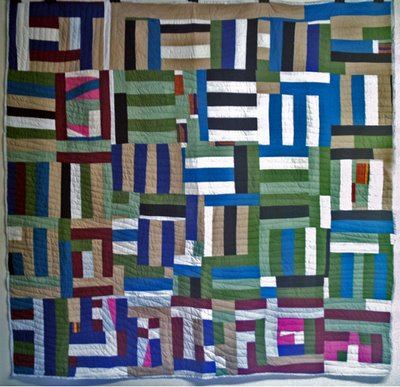 “…now it promised to set them free.”
“…now it promised to set them free.”
 Until recently, most quilts in Gee’s Bend were made from old, worn work clothes. In Gee’s Bend, these are the clothes of everyday life. Mary Lee Bendolph still works with this worn cloth, feeling the spirit and “warmth of lovely people” in her hands.
Until recently, most quilts in Gee’s Bend were made from old, worn work clothes. In Gee’s Bend, these are the clothes of everyday life. Mary Lee Bendolph still works with this worn cloth, feeling the spirit and “warmth of lovely people” in her hands.
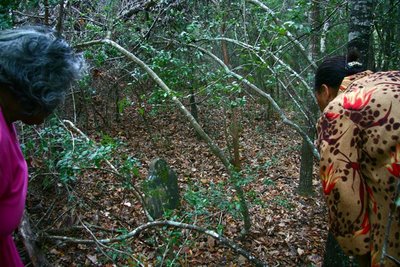 Our last morning in Gee’s Bend, we crashed through brush with Mary Ann and her sister Julia to find the nearly forgotten tombstones of slaveowner Mark Pettway’s family.
Our last morning in Gee’s Bend, we crashed through brush with Mary Ann and her sister Julia to find the nearly forgotten tombstones of slaveowner Mark Pettway’s family.
When Pettway bought the plantation in Gee’s Bend, he brought his hundred slaves from North Carolina with him. He made them walk all the way, except for his cook. He wanted her to be “fresh” to cook his family’s meals.
 Solomon, Mark Pettway’s son, died as an infant in 1850.
Solomon, Mark Pettway’s son, died as an infant in 1850.
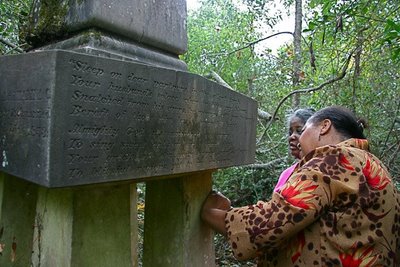 Even though Gee’s Bend is a small place, Mary Ann had never been here before.
Even though Gee’s Bend is a small place, Mary Ann had never been here before.
Like the North Carolina slaves he brought with him, the slaves Pettway acquired with the Gee’s Bend plantation took his last name. More than half the residents in Gee’s Bend still have this name.
 The old Big House, Pettway’s plantation house, has been knocked down now and is buried in brush.
The old Big House, Pettway’s plantation house, has been knocked down now and is buried in brush.
 But the memorial to his two daughters, both of whom died at age 24, nine or ten months after their marriage, in turn, to the same John E. Jones, still stands.
But the memorial to his two daughters, both of whom died at age 24, nine or ten months after their marriage, in turn, to the same John E. Jones, still stands.
Which left me feeling like Ike McCaslin reading old ledgers in Part IV of The Bear.
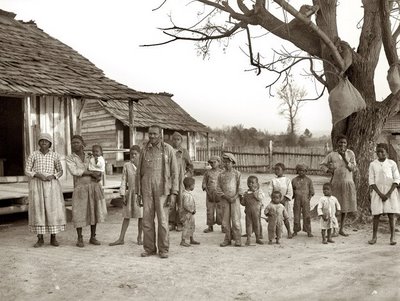 In the (last) Depression, cotton prices plummeted from 40 cents a pound to a nickel. Gee’s Bend sharecroppers and tenant farmers relied on credit to buy seeds and supplies, and the main creditor across the river in Camden warehoused their cotton until prices would rise again.
In the (last) Depression, cotton prices plummeted from 40 cents a pound to a nickel. Gee’s Bend sharecroppers and tenant farmers relied on credit to buy seeds and supplies, and the main creditor across the river in Camden warehoused their cotton until prices would rise again.
But he didn’t keep proper records, and when he died, his wife sent henchmen across the river to go from cabin to cabin to take everything they could: “tools, wagons, plows, furniture, eggs, hogs, mules.” Then the armed men “wended like a funeral procession back to the river,” taking with them everything a farming community needed for its survival.
That winter Gee’s Bend survived on plums and wildberries. They killed squirrels with slingshots. Fished some.
At times in its history, Gee’s Bend – and the whole of Wilcox County – has been recorded as being the poorest community in the United States.
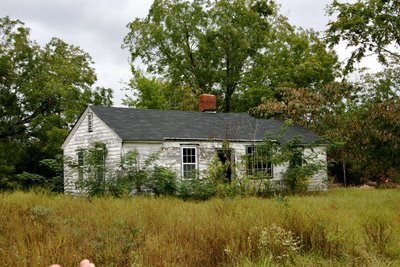 But Roosevelt’s New Deal came to the rescue. The farm administration bought the land in Gee’s Bend and “granted 100 families in Gee's Bend low-interest loans to buy modest farms and build new houses, with real glass windows and hardwood floors, the first some Benders ever set foot on.”
But Roosevelt’s New Deal came to the rescue. The farm administration bought the land in Gee’s Bend and “granted 100 families in Gee's Bend low-interest loans to buy modest farms and build new houses, with real glass windows and hardwood floors, the first some Benders ever set foot on.”
And these poor sharecroppers in Gee’s Bend became that rarest entity: black landowners in rural Alabama.
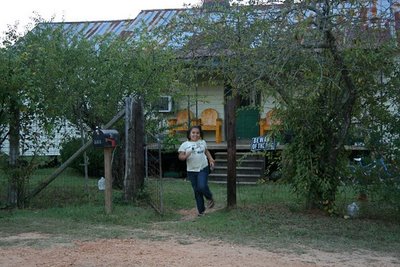 These “Roosevelt houses” are the predominant architectural feature in Gee’s Bend. Here’s young Julia running out from her own Roosevelt house to greet us.
These “Roosevelt houses” are the predominant architectural feature in Gee’s Bend. Here’s young Julia running out from her own Roosevelt house to greet us.
In Gee’s Bend you can’t help looking out on scenes like this and reflecting bitterly on how for fifty years Friedmanian “trickle down” economics has been trying to tear all this down.
Maybe now, though, we can see more clearly where these economics have gotten us.
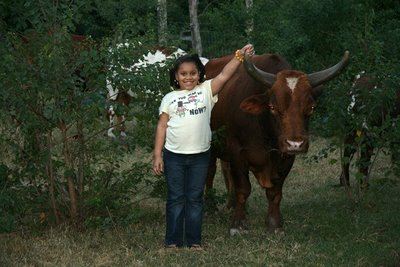 But even if I think bitterly of the ravages of “trickle down” economics, Debi and I don’t see a hint of bitterness anywhere in Gee’s Bend. We’ve never been in a community of more spontaneously kind and lovely people.
But even if I think bitterly of the ravages of “trickle down” economics, Debi and I don’t see a hint of bitterness anywhere in Gee’s Bend. We’ve never been in a community of more spontaneously kind and lovely people.
Given the history of Gee’s Bend – and even taking into account the community’s deep, genuine faith – we don’t have any idea of how to explain this.
 We weren’t savvy enough at the time to spend enough time with this old pickup truck or with other piles of old farming implements on this farm. But it’s quite possible, we realize now, that this is actually an “assemblage,” a deliberate commemoration to the father who once farmed here. You see the pine shoot growing right through the floorbed of the truck. This is actually a common theme: how from old, apparently discarded things, new life can come.
We weren’t savvy enough at the time to spend enough time with this old pickup truck or with other piles of old farming implements on this farm. But it’s quite possible, we realize now, that this is actually an “assemblage,” a deliberate commemoration to the father who once farmed here. You see the pine shoot growing right through the floorbed of the truck. This is actually a common theme: how from old, apparently discarded things, new life can come.
 And this is Allie Pettway, Gee’s Bend’s oldest quiltmaker.
And this is Allie Pettway, Gee’s Bend’s oldest quiltmaker.
Tomorrow we’ll tell you about Mary Lee Bendolph. Your homework assignment is to read Moehringer’s essay on Mary Lee and Gee’s Bend. If you can find the time, we promise you that you won’t regret it.



Reader Comments (6)
You're off to a great beginning. Is this the same group that was profiled on PBS a couple of years ago?
What a wonderful blog post! Thank You! I am fascinated by the quilters and love those quilts. I've read that essay soon!
Yes you're right, it was on PBS, Slim.
http://www.pbs.org/previews/quiltmakers_geesbend/
Debi
The photo of Mary Ann leaning in on the monument to the sisters. Wow. Long history in a moment. And this John Jones guy...two dead twenty four year old wives in a row. Any info there?
By the way, I passed the twin brother of the truck on the Mombasa Road the other day, still limpin' along with four goats in the back.
Go well.
Debi - What a beautiful blog and amazing pictures. Keri
When I started doing research into my maternal grandfather's family tree, I knew almost nothing. The two facts that I knew were that at one point in his life at the age of twenty-one he was a farm laborer's on Hollis Metcalfe Plantation in Metcalfe, Mississippi. This information was verified by his Draft Registration in 1917. My Mother did remember that he went into the Army when she was an infant or so she was told. The second fact was that he was born in Rehoboth, Wilcox, Alabama on December 14, 1896 according to his draft registration card. . After getting one hit on Ancestry. com, I first saw the name Gee's Bend for the first time in my life. This was in 2010 while my mother was still alive. This was more than she had discovered in her ninety years of life. So we then had his place of origin , his home when he was twenty-one and my mother remembered that his entire family moved to Chicago. ( She was the product of an unwed mother). I did find his death certificate and he died at the young age of twenty-eight years old. On the 1910 census, I did trace the family back to Gee's Bend, Alabama. My grandfather' s name was Robert Young. I have no idea why the Young 's name almost disappeared from the area by the 1920 census. I am planning to make the trip to find out more this fall. I am open to ideas on how to make the best use of my time in my search. I ran across this blog when I was doing one of my searches for more information. Would it be unrealistic to think the residents of Gee's Bend would be able to provide me with more history?